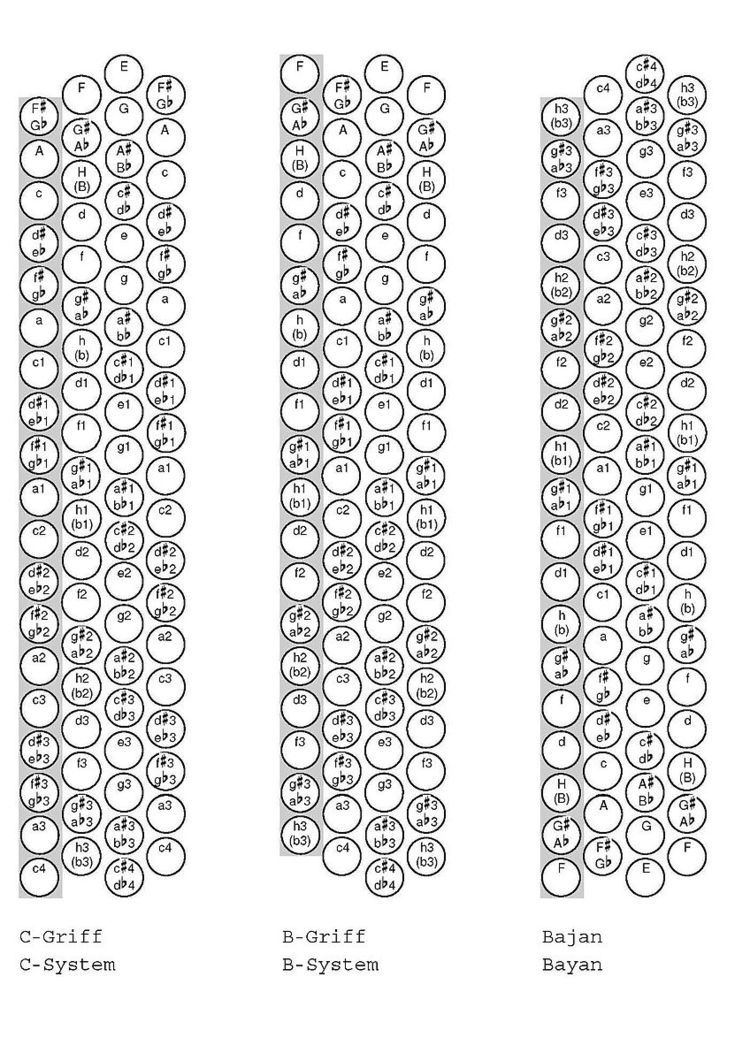 | ||
A free-bass system is a system of bass buttons on an accordion, arranged to give the performer greater access to playing melodies on the left-hand manual of the instrument and to forming one's own chords, by providing a buttonboard of single-note buttons with a range of three octaves or more, in contrast to the standard Stradella bass system which only allows bass notes (range of a major seventh) and preset major, minor, dominant seventh, and diminished chords. The term "free-bass system" refers to various left-hand manual systems that provide this functionality:
Contents
History
By the year 1900, the Stradella bass system had principally reached its current construction with 120 buttons over 6 rows. However, while that setup worked well for major and minor music accompanied by many chords, the performer would only have access to about a single octave of notes while playing - two with a timely shift of registers. The problem was solved in the early 1900s by adding three rows of chromatically ordered single notes next to the standard bass. In 1900 in Moscow Russian master Bakanov made a garmon with piano keyboards for both right and left hands. From 1906 the brothers Kiselevs' factory in Tula began to produce bayans with the three-row free-bass left keyboard.
In the United States, the virtuoso John Serry Sr. designed and built a working model of a Free-bass system to assist in the performance of both classical and symphonic jazz compositions in 1940. It incorporated dual key boards for the soloists' left hand based upon two sets of reeds which were tuned in octaves. This provided the soloist with a total range of tones which exceeded three and one half octaves. The dual keyboard design is illustrated below and was accessed through the use of a switch mechanism to provide independent access for the performers thumb onto Keyboard #2 and the performer's remaining fingers onto Keyboard #1.
Keyboard #2 __F#_G#_A#____C#_D#____F#_G#_A#____C#_D#____F#_G#_A#____C#_ Keyboard #2 _F__G__A__B__C__D__E__F__G__A__B__C__D__E__F__G__A__B__C__D_ Keyboard #1 __F#_G#_A#____C#_D#____F#_G#_A#____C#_D#____F#_G#_A#____C#__ Keyboard #1__F__G__A__B__C__D__E__F__G__A__B__C__D__E__F__G__A__B__C__D_Popularizing the free-bass accordion
The Hohner company decided to enlarge the market for accordions by turning the instrument from its traditional music roots into an established instrument for orchestras. An orchestra was put together, touring Germany to introduce the new concept. The company also supplied sheet music for this new type of accordion. Although these were reportedly popular, it was not until later when the instrument became more widespread.
In Northern Europe, free-bass accordionist Mogens Ellegaard helped popularize the instrument and inspire compositions for it. In an interview he describes how the free-bass accordion was still practically non-existent in his childhood (born 1935), but how composers in his native Denmark began to write works for him since 1958. In 1968 he arranged the manufacture of accordions with nothing but free-bass layouts to accommodate newcomers, as free-bass accordions would otherwise always include standard bass.
In some Russian, Canadian and European music conservatoires, free bass accordion is considered a serious instrument for study and there is now a large modern repertoire for it. In the United States, free bass instruments are much less well known despite attempts to popularize them by Palmer and Hughes and the Giulietti Accordion Company in the 1960s and 1970s. During this period several American accordionists demonstrated the unique orchestral sound of the instrument through live performances as well as by composing original works which featured the instrument. Included among this group was John Serry, Sr. whose Concerto For Free Bass Accordion was completed during the 1960s. (See Accordion music genres)
